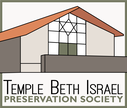|
Although the Red Sox lost to the Tampa Bay Rays on Wednesday, the Yiddish Chorus of the Boston Workers Circle, A Besere Velt (A Better World), was triumphant in its world premiere appearance at Fenway Park's home plate. What a thrill! Our very own, Norm Berman (President Emeritus and child of Holocaust survivors) sings tenor for A Besere Velt and chairs their steering committee. Have a listen here!
We are excited to announce that we have been awarded a Collections Assessment Grant for 2024! Read our press release.
The beautiful Temple Beth Israel in Danielson, listed on the National Register of Historic Places, celebrated its rededication on Sunday December 3, 2023. The day’s festivities began with opening remarks from President Paula Rosenberg Bell, the 3rd President of Temple Beth Israel Preservation Society following Joel Rosenberg and Norm Berman. Built by the original settlers following WWII and mostly by survivors of the Holocaust, it has shown its age and much restoration work was needed. Norm Berman gave a summary of events beginning with a panicked call from Rich Dvoran. Rich visits the Temple regularly to check for problems that may occur. A pipe had burst and there was substantial water damage. An emergency Board meeting was called and thanks to Evert Gawendo, his sons Michael and Jacob, immediate fixes to the burst pipes were performed and the long process of restoration began. A new roof was also needed. With support from a grant from the Connecticut Fund for Historic Preservation, insurance funds, donations and a lot of hard work and coordination, the necessary repairs to the interior and roof were completed... Today we celebrate a re-dedication attended by religious leaders and others in the Danielson area. Rev. Jane Newell, Kevin Brouillard, and Dr. Richard Herklots were among the guests who delivered messages of friendship and support.
Norm Berman and Leah Abrams led everyone in the singing of America the Beautiful and concluded the program with Hatikva - The Hope. Norm spoke some Yiddish, the preferred language of our immigrant parents and led the crowd in a Yiddish song – Ale Brider – We’re all brothers. Norm spoke of events that led to this day saying, “We are on a mission” – Tikun Olam (Repair the World)! When our parents settled here, Temple Beth Israel was their safe place. Today, we maintain the structure, we are building an archive to collect the stories and are committed to promoting social justice. Partnering with the Connecticut Humanities, a curriculum called “Lessons of the Holocaust”, was developed. Norm, Elizabeth Brouillard and Dr. Leah L. Forlivio are the team that created and bring this educational project into middle and high schools. It is available to Connecticut high schools and addresses bullying, hate and prejudice. The event also celebrated the launch of a new cookbook, Recipes Revival, a compilation of Jewish recipes from past and present which features recipes from the Temple Beth Israel sisterhood as far back as 70 years. Vita (Fetterman) Goldstein, who grew up in Danielson and now lives in Israel, was the chairperson of the cookbook project. Thanks to Vita and her committee’s diligent work, today this project has come to fruition. The binder style cookbooks went on sale ($25) and sales were brisk! You can still order one by clicking on the "Support" tab. Rabbi Howard Kosovske delivered blessings on the restoration of the building and a prayer for peace. A candle lighting ceremony followed. Marlon Schneider lit the first candle on behalf of the children of the founders. Following the Motzi from Rabbi Kosovske, refreshments, which included latkes, chili, fruits and desserts prepared from our newly refurbished kitchen, were served. Dr. Elsie Fetterman, the Temple’s first Sisterhood President, spoke about her experiences over the Temple’s 70 plus year history. We are all grateful for 96 year old Elsie’s contributions over many years! She remains very active and committed to our mission. Elsie’s family, the Blumenthal family were among the original founders whose vision and perseverance provided a Jewish center for religious and social activities to the local community and made today possible. Also recognized was Marty Weiner. Marty and his wife Naomi, who have been board members for many years. Marty accepted an award in recognition for all their contributions. Richard Dvorin was also honored with an award – Shomer Beit Ha Tefilla – one who watches over a house of worship - for his unyielding commitment to protecting the temple. Now that we are back in our building and properly rededicated, our mission continues to honor the past and enrich the future. In dire need of significant and immediate repairs to its building, Temple Beth Israel Preservation Society launched a capital campaign to raise $37,500. Our thirty year old roof which has been leaking for the past several years is in need of immediate replacement. A new roof and related repairs to the chimney and decking will cost nearly $50,000. Repairing and waterproofing exterior walls of the west end of the building and interior repairs will cost an additional $25,000.
The response from our community and friends has been amazing. In three short months, we have already raised nearly $25,000. We have applied for and been awarded a State of Connecticut Historic Restoration Grant to cover 50% of the roof repairs. We need to raise an additional $12,500 to meet our goal. The founders of this community were remarkable people. What better way to honor their memories, their struggles and their stories than to restore and preserve this building that meant the world to them? The Preservation Society continues to be the steward of a priceless legacy. These repairs will enable us to continue with our innovative and robust programming. Please help. We don't have that much further to go. Every dollar brings us closer to meeting our goal. |
© All Rights Reserved - Temple Beth Israel Preservation Society 2024


 RSS Feed
RSS Feed